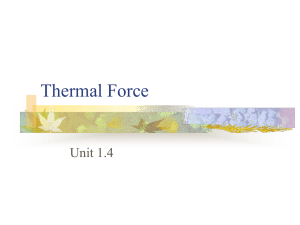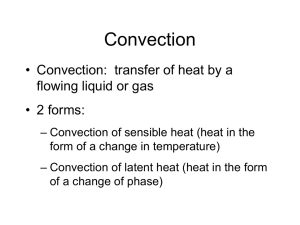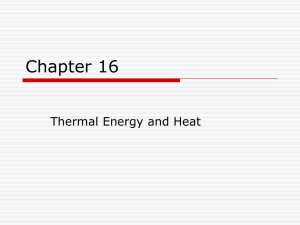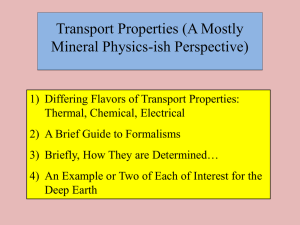Thermal properties - Biosystems and Agricultural Engineering
advertisement
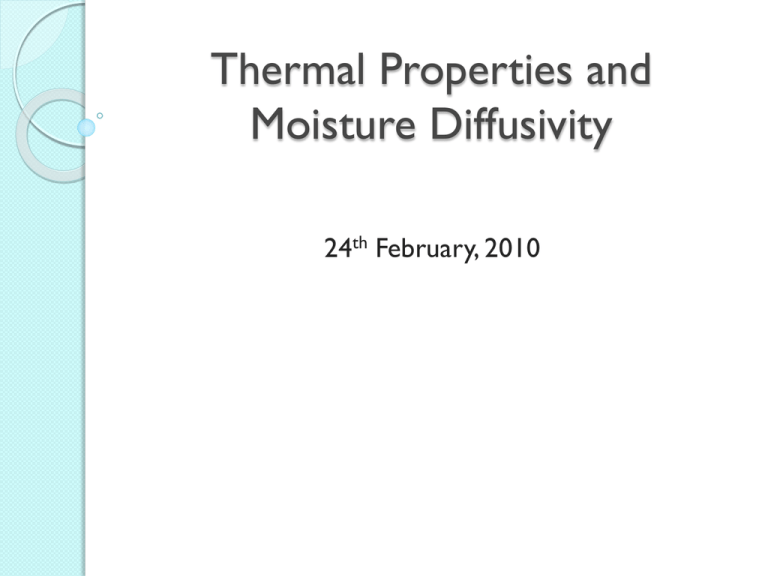
Thermal Properties and Moisture Diffusivity 24th February, 2010 Thermal Properties, Moisture Diffusivity Processing and Storage of Ag Products ◦ Heating ◦ Cooling ◦ Combination of heating and cooling Grain dried for storage Noodles dried Fruits/Vegetables rapidly cooled Vegetables are blanched, maybe cooked and canned Powders such as spices and milk: dehydrated Cooking, cooling, baking, pasteurization, freezing, dehydration: all involve heat transfer Design of such processes require knowledge of thermal properties of material Continue…. Heat is transferred by Conduction: Temperature gradient exists within a body…heat transfer within the body Convection: Heat transfer from one body to another by virtue that one body is moving relative to the other Radiation: Transfer of heat from one body to another that are separated in space in a vacuum. (blackbody heat transfer) We’ll consider Conduction w/in the product Convection: transfer by forced convection from product to moving fluid Moisture movement through agricultural product is similar to movement of heat by conduction Moisture diffusivity Volume change due to moisture content change Continue…. Terms used to define thermal properties Specific heat Thermal conductivity Thermal diffusivity Thermal expansion coefficient Surface heat transfer coefficient Sensible and Latent heat Enthalpy Specific Heat Specific Heat: Amount of heat required to raise temperature of unit amount of substance by one degree Units: ◦ ◦ ◦ 𝐾𝐽 𝐾𝑔°𝐾 𝐵𝑇𝑈 lb°𝐹 𝐶𝑎𝑙. 𝑔°𝐾 (SI System) (English System) (if calories are used) Conversion of units: 1 𝐾𝐽 𝐾𝑔°𝐾 = 0.239 𝐵𝑇𝑈 lb°𝐹 = 0.239 𝐶𝑎𝑙. 𝑔°𝐾 Specific Heat Once Specific heat of material is known, then the amount of heat (Q) needed to increase temp. from T1 to T2 is calculated by: Q = M Cp (T2-T1) Where, Q = quantity of heat required to change temperature of a mass Cp = Specific heat at constant pressure M = mass or weight Water is a major component of all agricultural products 𝐾𝐽 𝐵𝑇𝑈 𝐶𝑎𝑙. Cp of water = 4.18 =1 =1 𝐾𝑔°𝐾 lb°𝐹 𝑔°𝐾 Cp of oils and fats = ½ of Cp of water ………See Table 8.1 pg. 219 Cp of grains, powders = ¼ to 1/3 of Cp of water Cp of ice = ½ Cp of H2O ( therefore, less heat required to raise temp. of frozen product then the same product when it is thawed) Specific heat Eq. for calculating Cp based on moisture Content For liquid H2O Cp = 0.837 + 3.348 M above freezing For solid H2O Cp = 0.837 + 1.256 M below freezing Eq. based on composition Cp=4.18Xw+1.711Xp+1.928Xf+1.547 Xc+0.908Xa X is the mass or weight fraction of each component The subscript denote following components: w=water, p= protein, f=fat, c= carbohydrate, a=ash Thermal Conductivity (k) Measure of ability to transmit heat 𝑑𝑄 𝑑𝑡 = -k A 𝑑𝑇 𝑑𝑥 K= coefficient of thermal conductivity For one dimensional heat flow in x direction, k is numerically equal to the quantity of heat (Q) that will flow across a unit cross sectional area (A) per unit of time (t) in response to a temperature gradient 𝑑𝑇 ( ) of 1 degree per unit distance in x direction 𝑑𝑥 Units: 𝑊 m°𝐾 𝐵𝑇𝑈 h ft °𝐾 (SI system) (English System) 1 𝐵𝑇𝑈 h ft °𝐾 = 1.731 𝑊 m°𝐾 Thermal Conductivity (k) k water =0.566 at 0°C = 0.602 at 20°C = 0.654 at 60°C At room temp. value of k for endosperm of cereal grains, flesh of fruits and veg., dairy pdts, fats and oil and sugar are less than that of water. Higher the moisture content higher will be thermal conductivity of food product Another factor is porosity e.g. freeze dried products and porous fruits like apple have low thermal conductivity. Thermal Conductivity (k) If we don’t know thermal conductivity, approximate using... K = kw Xw + ks(1-Xw) Where, Kw =Thermal conductivity of water Xw= Weight fraction of water Ks = Thermal conductivity of solids = 0.259 𝑊 m°𝐾 If the moisture in product is more than 50%, then K = 0.056 + 0.57Xw Thermal Diffusivity (α) α quantifies the materials ability to conduct heat relative to its ability to store heat. α= 𝑘 𝞺 𝐶𝑝 Where, 𝑚2 𝑓𝑡2 α = Thermal Diffusivity, Units ( ) or ( ) 𝑠𝑒𝑐 𝑠𝑒𝑐 k = Thermal conductivity 𝞺 = density of material 𝐶𝑝 = Specific heat at constant pressure Example : Estimate the thermal diffusivity of a peach at 22 C. Surface heat transfer coefficient (h) When a body is placed in flowing stream of liquid or gas, the body’s temperature will change until it eventually reaches in equilibrium with the fluid. In eq. form also known as Newton’s Law of cooling Where, 𝑑𝑄 𝑑𝑡 = h A (Tf- Ts) 𝑊 h = surface heat transfer coefficient and has same units as k i.e. m°𝐾 Tf = temp. of fluid Ts = temp of solid body h depends on fluid velocity, surface characteristics of solids, size and shape of solid and fluid properties ( density and viscosity) Difficult to tabulate value of h, therefore experimentally determined Sensible and Latent heat Sensible heat: Temperature that can be sensed by touch or measured with a thermometer. Temperature change due to heat transfer into or out of product Latent heat: Transfer of heat energy with no accompanying change in temperature. Happens during a phase change...solid to liquid...liquid to gas...solid to gas Latent heat (L) Latent Heat, L, (kJ/kg or BTU/lb) Heat that is exchanged during a change in phase Dominated by the moisture content of foods Requires more energy to freeze foods than to cool foods (90kJ removed to lower 1 kg of water from room T to 0 °C and 4x that amount to freeze food) 420 kJ to raise T of water from 0 ° C to 100 ° C, 5x that to evaporate 1 kg of water Heat of vaporization is about 7x greater than heat of fusion (freezing) Therefore, evaporation of water is energy intensive (concentrating juices, dehydrating foods…) Latent heat (L) Determine L experimentally when possible. When data is not available (no tables, etc) use…. L = 335 Xw where Xw is weight fraction of water Many fruits, vegetables, dairy products, meats and nuts are given in ASHRAE Handbook of Fundamentals Enthalpy (h) Units: (kJ/kg or BTU/lb) Heat content of a material. Used frequently to evaluate changes in heat content of steam or moist air Combines latent heat and sensible heat changes ΔQ = M(h2-h1) Where, ΔQ = amount of heat needed to raise temperature from T1 to T2 M = mass of product h2= enthalpy at temp T1 h1 = enthalpy at temp T2 Enthalpy (h) Approach useful when one of the temperature is below freezing Measurements based on zero values of enthalpy at a specified temperature e.g. at -40°C, -18°C or 0°C. Enthalpy changes rapidly near the freezing point Change in enthalpy of a frozen food can be calculated from eq. below: Δh = M cp(T2 – T1) + MXw L Xw is the mass fraction of water that undergoes phase change(frozen fraction) L is the latent heat of fusion of water M is the mass of product Δh = Change in enthalpy of frozen food Example Example 8.3: Calculate the amount of heat which must be removed from 1 kg of raspberries when their temperature is reduced from 25C to -5C. Assume that the specific heat of raspberries above freezing is 3.7 kJ/kgC and their specific heat below freezing is 1.86 kJ/kgC. The moisture content of the raspberries is 81% and the ASHRAE tables for freezing of fruits and vegs. Indicate that at -5C, 27% will not yet be frozen. Homework Assignment Due March 7th Problem 1: Determine the amount of heat removed from 3 kg of bologna (sausage) when cooled from 23C to -7C. Assume MC of 59% and at -7C, 22% won’t be frozen. Problem 2: Estimate the thermal diffusivity of butter at 20°C.




